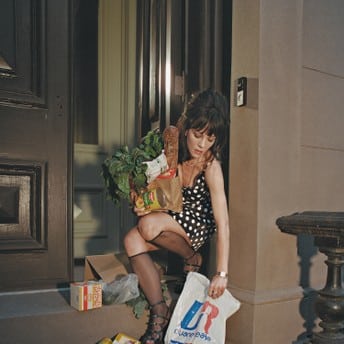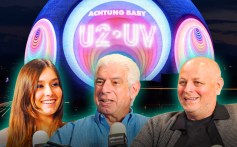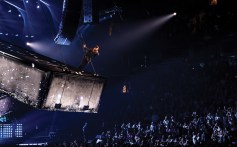Touring
Page: 3
Trending on Billboard
The Weeknd‘s massive After Hours Til Dawn tour has racked up yet another huge record thanks to worldwide grosses topping $1 billion. According to a statement from Abel Tesfaye’s team, the grosses make the AHTD outing the top-earning tour by a male solo artist in history.
Explore
See latest videos, charts and news
The billion mark was crossed following the recent onsale dates for upcoming spring and summer 2026 dates in Mexico, Brazil, Europe and the U.K., which bumped the tour’s total ticket sales to more than 7.5 million to date across 153 shows since its July 14, 2022 kick-off at Lincoln Financial Field in Philadelphia.
In mid-August, Billboard Boxscore reported that at that point the tour had grossed $635.5 million and sold 5.1 million tickets since launching, making it the biggest R&B tour in history. That meant that AHTD easily overtook Beyoncé’s 2023 Renaissance World Tour, which took in $579.8 million over 56 shows. The Weeknd lapped Queen Bey when it crossed the $600 million mark following two return performances at Philly’s Lincoln Financial Field on July 30-31.
The gaudy numbers for AHTD made it the ninth tour to hit the $600 million and above mark, with the Weeknd the only R&B and Black artist on a list that features pop and rock acts including Elton John and Harry Styles. The Weeknd’s attendance at the shows is also a record-setter according to Billboard Boxscore, making him the only genre act and only Black artist to sell more than five million tickets on a single tour, as well as just one of eight to sell more than five million tickets and gross more than $600 million.
In addition to the record-setting box office figures, the singer’s team said to date the Weeknd has donated more than $8.5 million to his XO Humanitarian Fund as well as to Global Citizen, with additional proceeds from the 2026 dates set to continue supporting World Food Program Global Citizen.
After the 2025 North American stadium leg featuring 40+ sold out shows set highest attendance records by a Black male artist at venues in New York, Denver, Santa Clara, Seattle, Edmonton, Montreal, Orlando, Arlington and Houston, as well as breaking the all-time record for the most shows by a male solo artist on a single tour with six performances at Toronto’s Rogers Centre, the trek will continue next year with 40 more dates in Mexico, Brazil, Europe and the U.K. The next leg kicks off on April 20 with the first of three stop at Estadio GNP Seguros in Mexico City.
Tate McRae wrapped the Miss Possessive Tour in Los Angeles on Nov. 8. Since kicking off in March, the tour grossed $110.8 million and sold 1 million tickets over 77 shows, according to figures reported to Billboard Boxscore. It’s easily the biggest of McRae’s fast-growing career, quintupling the earnings of her previous tour, just one year ago.
Related
It’s another year in a successive growth pattern for McRae. She’s toured for the last four years, building upon each in every metric. She averaged 1,084 tickets per show in clubs on her reported dates from 2022, before scaling to 2,607 in 2023. Last year, she stretched to 5,999, before elevating to sold-out arenas, with an average of 13,480 tickets in 2025. This is the third consecutive year that she doubled her nightly ticket sales.
Compounded by surging demand and an ever-increasing ticketing market, McRae’s earnings grew even bigger. She’s up from a per-show average of $26,600 in 2022, to $96,800 in 2023, to $349,000 in 2024, and now to $1.4 million in 2025. She grew by 265%, then 261% and then again by 312%.
McRae’s busy touring schedule has complemented a nearly constant output of new music. I Used to Think I Could Fly was released in May 2022, followed by Think Later in December 2023 and So Close to What in February 2025.
McRae’s numbers have soared on a per-show basis, but she’s also added more dates to her schedule each year, creating exponential growth to her total figures. The Miss Possessive Tour is her first to sell more than a million tickets and gross more than $100 million, and she hadn’t come close before: The tour’s total attendance triples last year’s count of 336,000, and the total gross laps last year’s $19.6 million five times over.
The Miss Possessive Tour started on March 18 with one show in Mexico City before a string of Latin American festival slots. McRae played 26 shows in Europe ($27.9M; 359K tickets) and then 50 in the United States and Canada ($82.7M; 673K). Both regions were up, to say the least, from last year, with North America earning more than seven times its 2024 gross.
That global growth can be distilled to the local level. In New York, McRae has evolved from one show at Irving Plaza (1,200 capacity) in 2022, to two at The Rooftop at Pier 17 (7,494 tickets in 2023). She played her first solo headline show at Madison Square Garden in 2024 (12,458) and then played three in 2025 (41,503). She also had three arena shows in the Los Angeles area, selling 42,224 tickets at Kia Forum in Inglewood, Calif., up 612% from last year’s lone show at the Greek Theatre (5,930).
Over the course of three years, McRae has expanded her nightly reach by more than 5,300%. Fellow emerging pop stars have experienced similar growth in the last decade, but it hasn’t been quite as speedy. Both Billie Eilish and Dua Lipa kicked off their latest arena spectacles last fall, two years removed from the end of their previous tours. McRae, on the other hand, has fired off three tours in three years, with no more than six months in between any of them.
In the eight months since her latest album became her first No. 1 on the Billboard 200, she topped the Billboard Hot 100 alongside Morgan Wallen on “What I Want” and scored her first Grammy nomination with F1’s “Just Keep Watching.”
Now, McRae is preparing the deluxe release of So Close to What, set to drop on Friday (Nov. 21). It’s led by “Tit for Tat,” which debuted on the Hot 100 at No. 3 in October. In the year since the Miss Possessive Tour dates went on sale, she’s created enough new momentum to continue this growth into the latter part of the 2020s.

Trending on Billboard
Just when it seemed that Lily Allen’s West End Girl campaign couldn’t get any bigger, the singer has added a run of arena shows to her 2026 U.K. tour.
The new dates, which include a night at London’s 20,000-capacity O2 Arena, will join Allen’s previously announced shows, which take place in theaters across the country throughout March.
Explore
See latest videos, charts and news
The arena leg of the tour will kick off at Newcastle’s Utilita Arena on June 2. She’ll head to Glasgow, Manchester, Leeds, Nottingham, Cardiff, Birmingham and London before traveling to Ireland for a night at Dublin’s 3Arena on June 30. It will mark the biggest headline tour of Allen’s career.
Tickets go on sale on Nov. 27 at 10 a.m. GMT. Fans can find further ticketing information on Allen’s website.
The show – Lily Allen Performs West End Girl – will see the British star perform her new album front to back. Released Oct. 24, the LP hit a peak of No. 2 on the Official U.K. Albums Chart, marking her highest placement on the list since 2014’s Sheezus. Prior to the arena gigs, Allen will also perform West End Girl for a headline slot at Mighty Hoopla festival in London’s Brockwell Park on May 30.
West End Girl has repeatedly hit the headlines in recent weeks. The album appears to tell the story of the dissolution of Allen’s marriage to Stranger Things actor David Harbour in chronological order, traversing the start of an open relationship, scenes of alleged infidelity and a subsequent breakdown of trust.
Speaking to British Vogue prior to its release, Allen likened the album to a work of autofiction. She told the publication that its lyrical content was inspired by her marriage, but “that’s not to say it’s all gospel.” Allen and Harbour tied the knot in Las Vegas in 2020 after meeting on dating app Raya the year prior.
West End Girl is Allen’s first album since 2018’s No Shame and her fifth full-length release overall. Allen’s debut LP, Alright, Still hit No. 2 on the U.K. charts in 2006, while its predecessor, It’s Not Me, It’s You (2009) reached the summit.
Allen will return to Saturday Night Live on Dec. 13, appearing on the show as a musical guest for the first time since 2007. Actor Josh O’Connor is set to make his debut as host that night.
Check out the updated list of Lily Allen Performs West End Girl tour dates below:
March 2: Glasgow, Scotland @ Royal Concert Hall
March 3: Liverpool, England @ Philharmonic Hall
March 5: Birmingham, England @ Birmingham Symphony Hall
March 7: Sheffield, England @ Sheffield City Hall
March 8: Newcastle, England @ Newcastle City Hall
March 10: Manchester, England @ Aviva Studios, The Hall
March 11: Manchester, England @ Aviva Studios, The Hall
March 14: Nottingham, England @ Nottingham Royal Concert Hall
March 15: Cambridge, England @ Corn Exchange
March 17: Bristol, England @ Bristol Beacon
March 18: Cardiff, Wales @ Cardiff New Theatre
March 20: London, England @ London Palladium
March 21: London, England @ London Palladium
May 30: London, England @ Mighty Hoopla Festival
June 16: Newcastle, England @ Utilita Arena (new date)
June 17: Glasgow, Scotland @ OVO Hydro (new date)
June 19: Manchester, England @ AO Arena (new date)
June 21: Leeds, England @ First Direct Arena (new date)
June 23: Nottingham, England @ Motorpoint Arena (new date)
June 24: Cardiff, Wales @ Utilita Arena (new date)
June 26: Birmingham, England @ BP Pulse Live (new date)
June 27: London, England @ The O2 (new date)
June 30: Dublin, Ireland @ 3Arena (new date)
Trending on Billboard AEG Presents UK has announced new details about British Airways ARC, an upcoming 3,800-capacity live music venue and event space above the west exhibition hall at the Olympia convention space in London. Set to open in 2026, British Airways ARC is part of a $1.7 billion renovation of Olympia — a 138-year-old […]
Trending on Billboard Calvin Harris is moving his overseas talent bookings from WME to agent Brent Smith at Wasserman Music, who has long managed his U.S. bookings, sources tell Billboard. Smith formerly worked at WME and left the agency for Wasserman in late 2020. Related Representatives for Harris say the Scottish EDM artist, known for […]

Trending on Billboard
Aspen Live, the annual live music industry conference, is returning to Aspen, Colo., Dec. 4-6. Capped at an attendance of 150 people and scheduled around Colorado’s winter activities, the event is the brainchild of longtime touring and event producer Jim Lewi, who heads up production and business development for Embarc Events.
“The first year we did it in 1996, everybody who came was a skier or snowboarder,” says Lewi. “It was dumping snow, and everybody wanted to go out and ski. So I said, ‘Okay, no meetings until after the lifts close.’”
Related
That philosophy continues today, even though only half of the attendees ski or snowboard, according to Lewi. Mornings feature a group breakfast, followed by activities — skiing, cooking classes, nature walks — that are designed to keep attendees networking. Panel discussions happen in the afternoons, followed by cocktail parties and dinners around town.
The conference’s most anticipated panel brings together Dave Marcus from Ticketmaster, Dean DeWulf from AXS and Sean Stewart from StubHub, moderated by manager Randy Nichols. It’s a lineup that Lewi acknowledges could get contentious.
“I warned StubHub before they said yes that it could get rough with people in the room,” Lewi says. “But this is part of our distribution network now. We can fight it, or we can do business with them and try to get rid of the bots.”
Lewi sees the secondary market as an opportunity for rights holders to capture upside they’re currently missing. “If you’re gonna charge more money for my ticket, I want to get paid on the upside,” he explains. “That’s Sean’s job — to have that direct relationship with the rights holders.”
Related
Aspen Live’s programming reflects Lewi’s belief that the live music industry can learn from adjacent sectors. One panel focuses on Latin music, exploring how that market has grown beyond border states to continually expand its audience. Another panel brings together performing arts center executives with venue operators and artist managers.
“How do we utilize their models?” Lewi asks. “They have subscribers, they have mailing lists, they book further in advance. What can we learn from them?”
Perhaps most intriguing is a session featuring representatives from minor league baseball team the Nashville Sounds. “They sell more tickets than Major League Baseball, without the names, without the money,” Lewi says. “How are they so good at engaging fans? They’re selling the same product over and over again.”
What distinguishes Aspen Live is its commitment to honest discourse in an intimate setting. “We want it to be more of a discussion and a dialogue than a monologue,” Lewi says. “People yell out their own thoughts throughout the meetings.”
Related
Lewi notes with pride that the conference has spawned numerous business relationships and partnerships over the years: “A lot of people have created their whole business out of Aspen,” he says.
As the live music industry faces mounting challenges — from affordability concerns to changing consumer behavior — Aspen Live’s intimate, problem-solving approach feels increasingly relevant. As Lewi puts it, the goal is for the industry to find sustainable models in an increasingly difficult market.
“The theme is always, ‘Solve problems and try to learn from each other,’” Lewi says. “I’ve always been very dreamy. I dream that Aspen becomes a place where problems can be resolved.”
Learn more and register at AspenLive.com.
Trending on Billboard
The 2020s have been a turbulent time for agents and the musicians they represent. The decade started off with an unprecedented global pandemic that forced the shutdown of live shows indefinitely, and as lockdown orders lifted, early concerts often dealt with no-shows, rising costs and an over-supply of acts going back on the road at once.
Now, in 2025, the live music market is stabilizing, but it’s never looked quite like this. Artists are bringing more production value to shows than ever, festival ticket sales are softening and talents like Harry Styles and Beyoncé are offering fewer tour stops — but more nights in each location.
Related
Creative Artists Agency’s (CAA) top agents are in the midst of it all, often singlehandedly sparking trends with the decisions they make with their superstar clients when they are ready to hit the road. To talk through the evolution of live entertainment post-pandemic, CAA managing director Rob Light (Bruce Springsteen, Beyoncé, Ariana Grande, Fleetwood Mac) and co-head of global touring Rick Roskin (Slipknot, Eric Clapton, Santana, Kelly Clarkson) joined Billboard‘s new music industry podcast, On the Record w/ Kristin Robinson, this week.
Below is an excerpt of that conversation.
Watch or listen to the full episode of On the Record on YouTube, Spotify or Apple Podcasts here, or watch it below.
How did you make sure to help your artists’ tours stand out after pandemic lockdowns lifted and everyone rushed back onto the road?
Roskin: You have to make a statement because there’s a ton of volume. I mean, you can look at what plays in every city on a weekly basis, and there are a ton of shows. So somehow you have to figure out a way to cut through the clutter and break through and get noticed.
Light: A great example of that was three summers ago was with Harry Styles and his management team. Harry could have easily sold out two or three or four nights at MetLife Stadium. But everybody was playing Met Life Stadium. It wasn’t a big event, everybody was doing it. They came up with the idea of ‘let’s do 15 nights at Madison Square Garden.’ And he owned New York. Didn’t matter who was playing stadiums those nights. Everybody was talking about that move. It was a huge statement and intentional. I really do believe, you know, trying to find those moments are really part of our job. You can’t create them every day. You can’t create them on every tour, but any moves you’re making should hopefully lead to something.
Related
We’re also seeing artists like Beyoncé doing fewer cities, but more dates within those cities. I’m wondering why you think that’s occurring now?
Light: The cost of touring has gone up exponentially and the size of these productions becomes more and more intricate so that if you can sit in one place you can actually make them a little bigger and better — and the audience is willing to come to you. Beyoncé goes to New York for a week, for example, and Boston, Washington and Philly, they’re all gonna come to her if that’s the only place to see it. Also, if you have kids, sitting in one place actually makes touring more palatable.
I don’t think that the idea of day-to-day playing a city, getting on a bus and going to the next will ever go away, but if you have control of your career at that moment, it’s certainly easier to tour this way.
Roskin: To get a little technical, you know, a huge tour eight years ago or ten years ago, was about 13 semi-trucks [of production equipment]. I mean, that would be like, ‘Oh my God. That is a massive tour.’ You know, tours now are carrying 30, 40, 50 trucks of production. To move that is incredibly expensive. Everything has been amped up. In this boom post-Covid, artists are taking it to a level that no one’s ever seen before…Actually — The Weeknd’s stadium tour had about 60 trucks.
Let’s talk about Coachella 2026. Coachella decided to put its tickets for 2026 on sale very early this year. I have to say, I read that at the time as them maybe being nervous about not selling out. I know that that’s been an increasing issue for them over the last few years, but Coachella 2026 sold out pretty immediately. Why do you guys think it sold so quickly?
Light: Nothing replaces star power, and it’s a great lineup. Let’s be fair, but I think part of the reason they decided to go earlier is that they realize the public is getting more and more trained to buying earlier and so waiting till January feels late now… It was a great way for Coachella to make a statement about the festival season. They want to buy in advance, they want to make those plans, they want to be able to travel. I think was very smart on Paul [Tolette] and his team’s part to go earlier, and when you have that lineup — with Sabrina [Carpenter] and Justin [Bieber] — you’re going to do great. Why not go early?
Related
In general, it seems like festivals aren’t quite as hot as they used to. Ticket sales across the board are softening. Why do you think that is happening now?
Light: There’s a lot of factors. There’s no one answer that fills the floor. Part of it is, you’ve got so many shows and ticket prices have gone up. There’s decisions being made now, like ‘how much money do I have?’ I have to pick and choose where I am going to go. Part of it is who the headliners are, and then another part of it was just a proliferation of festivals. They were everywhere and you couldn’t go to every one. So when you feel softness at the edges, it’s really a function of ‘I can’t beat everyone. I have to pick and choose.’
Lately, festival attendees are arriving later to the festival, which means those baby artists who are at the bottom of the poster and the top of the day are going to have even less crowds than before. I’m wondering, do you still think that, for emerging artists at CAA, that being on those festival lineups is still as worthwhile as it once was?
Light: I’ve said this for years about those slots, and this is where agents really play a role in the artist development of a career. Part of getting on a festival is being on the poster. You want to be part of that and playing at 12 or one or two o’clock may not be great, but a great agent is going to stop and say, How do I get back to that market within four or five months of having done that gig? Because two or 3,000 kids who might have seen me and have told their friends now want to be able to see them on their own, and so to just show up anywhere and play one day at two o’clock and disappear for a year? Is bad management, bad agenting. If you’re going to get one of those slots, how am I going to take advantage of that moment and make other things happen off the back of it?
Related
Along with the cost of touring rising, we’re also seeing ticket prices rise as well. I remember that Bruce Springsteen tried dynamic ticketing a few years ago, and that led to some of the tickets ending up being thousands of dollars. I’m wondering now, a few years later, like we’re reflecting back on that, how you feel about dynamic ticketing as a model for big tours?
Light: Bruce got a really bad rap because at that same time that one guy bought a ticket at a high price, Elton John and the Rolling Stones were charging tickets for twice the price. But because he was a working man, somebody took a shot at him. There’s always going to be supply and demand. It just is. And what we try to create, and all the ticket companies try to create, is the closest way to be fair, where the money is going to the artist, right? If we’re going to do dynamic pricing, and you’re buying a ticket at a higher price, but the artist is getting paid. He or she deserves that. They built that career. What we hate is when you know, scalpers and bots and stub hubs and all these middle people now are making money with no skin in the game. They did nothing other than got a ticket, and now they’re reselling it. The artist doesn’t see any of that money…But I’m a fan of dynamic pricing, simply because it allows everybody to be equal in the process so if I can afford it, and it’s a show I want to see, I get to pay for it. I want to see the artist get paid. I don’t want to see some outlier get paid.
The federal government is attacking Ticketmaster on multiple fronts right now. This includes the FTC suing the company, and it has to deal with resale. Do you think that Ticketmaster should play a part in the resale of tickets, and if it does, does there need to be a cap on the secondary market?
Roskin: On platinum ticketing, most artists have a cap on what they allow the tickets to sell for, usually the cap ranges from two to three times value. So even if the secondary tipping market exceeds that, it doesn’t feel like it’s so harsh. But as far as the secondary ticketing market goes, it isn’t going anywhere.
This was one of Rob’s stories, but I’ll tell it. Years and years ago, AC/DC was doing a tour, and they go out on the road, and they’re like, ‘we’re gonna sell all tickets paperless. You’re gonna have to walk in with your credit card, scan your credit card at the door. They’re gonna see your name. You go into the venue,’ and through this they thought they were going beat scalpers, and they’re going to finally win. What ends up happening is that the scalpers sent gift cards to their own people who bought tickets, and they walk up with the gift cards, scan the tickets, and they beat AC/DC’s brilliant idea to get rid of scalpers. They are always gonna find a way to get ahead. Be it bots, be it AI, whatever — it is our responsibility as agents is to figure out ways that as much money stays with the artist.
Trending on Billboard
Europe’s largest music market will soon be announcing a ban on ticket resale for profit, elating music fans while roiling investors in secondary ticketing companies like StubHub and Vivid Seats.
Multiple outlets in the United Kingdom are reporting that the Labour Party government of Prime Minister Keir Starmer will announce a plan to crack down on ticket scalping this week. Outlets like The Guardian are reporting that Starmer’s government had considered capping resale at 30% above a ticket’s original face value, but ultimately opted to ban the resale of tickets above face value following significant pressure from artists and industry groups.
Related
According to The Guardian, ticket holders for popular concerts like Coldplay and Dua Lipa will be able to resell tickets on sites like StubHub and Viagogo, but not charge more than they paid for the tickets. Resale sites would be allowed to charge fees on top of that price, but the fees would be limited and set by regulators. The resale ban would also cover social media sites, which some resale site operators have claimed would serve as fraud-heavy alternatives if markets like StubHub were shut down.
The new regulations will also include purchasing limits on tickets and mandates from the Competition and Markets Authority (CMA) that resale sites like StubHub will be responsible for policing their own platforms.
The news sent the share price for StubHub’s U.S. company, StubHub Holdings, tumbling on Monday (Nov. 17); the stock ultimately closed down 13.8 percent. StubHub has endured a brutal November, with shares down a combined 33% after the company failed to provide a financial forecast for the current quarter.
The publicly traded StubHub Holdings — which owns Viagogo — is a different company from the U.K. StubHub brand. The Competition and Markets Authority forced the firms to split into two companies following the merger of Viagogo and StubHub in 2020.
Representatives for Live Nation applauded the deal, telling Billboard in a statement that “Live Nation fully supports the UK government’s plan to ban ticket resale above face value. Ticketmaster already limits all resale in the UK to face value prices, and this is another major step forward for fans — cracking down on exploitative touting to help keep live events accessible. We encourage others around the world to adopt similar fan-first policies.”
Earlier this month, more than 40 British artists, including Sam Fender, Radiohead and The Cure, sent a public letter to Starmer urging the U.K. prime minister to “stop touts [scalpers] from fleecing fans” and cap the price of resale tickets at face value. The pressure campaign followed a recent CMA study that found U.K. tickets sold on resale sites were typically marked up 50 percent.
Trending on Billboard
Fresh off the heels of her third one-hour Netflix special, Upper Classy, actress and comedian Cristela Alonzo will embark on her multi-city Midlife Mixtape Tour beginning next January.
The North American tour showcase kicks off Thursday, Jan. 15 at Quezada’s Comedy Club in Santa Ana Pueblo, New Mexico, with additional stops in Chicago; San Diego; Houston; Scottsdale, Arizona; Spokane, Washington; and San Antonio, Texas before wrapping up in Las Vegas at the Westgate Resort on May 2.
Tickets will go on sale starting Friday at 10 a.m. local time. More information can be found at CristelaAlonzo.com
The tour will also land at the Moontower Comedy Festival in Austin, Texas, on April 9 and 10. Tickets for the festival, which are already on sale, can be found here.
A first-generation Mexican-American, Alonzo grew up in poverty in San Juan, Texas, learned English from watching TV, and in 2014 adapted her story into the ABC comedy Cristela, becoming the first Latina to create, produce and star in her own network sitcom.
Her latest Netflix special Upper Classy, which debuted in late September, recently landed in the streamer’s top 10 most-viewed programs, following her acclaimed hours Middle Classy and Lower Classy.
In October, Billboard contributor Joe Levy wrote of Upper Classy, “To say that Alonzo is in the tradition of observational comics who mine their life experience for comedy is to underestimate both her mastery of that tradition, as well as its impact on her.”
Alonzo also voices Cruz Ramirez in Pixar’s Cars 3 and appears in the Hulu series This Fool. In 2019, she published Music to My Years: A Mixtape Memoir of Growing Up and Standing Up.
Cristela Alonzo: Upper Classy. Cristela Alonzo at the Majestic Theatre in Dallas, Texas.
Lauren Smith/Netflix

Trending on Billboard After going big and weird this year, “Weird Al” Yankovic is going even Bigger & Weirder again next year. In a cinematic Instagram video (watch below), the parody song superstar announced the dates for the next chapter of his ongoing tour on Monday morning (Nov. 17), which is slated to kick off […]

 State Champ Radio
State Champ Radio 






